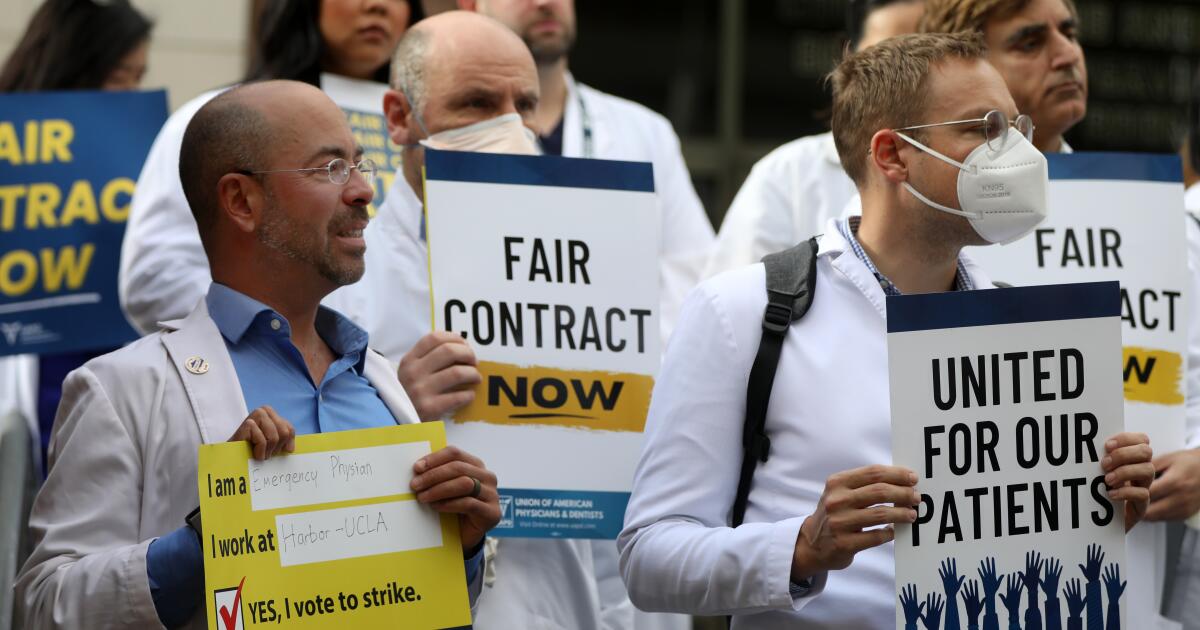Science
Doctors and dentists at L.A. County-run hospitals will get bonuses under tentative deal

Unionized doctors and dentists who work at hospitals and other health facilities run by Los Angeles County will get cost-of-living increases and bonuses under new agreements with the county, reached after more than two years of bargaining and threats of a strike.
The tentative agreements with a pair of bargaining units represented by the Union of American Physicians and Dentists are expected to be voted on this month by the Los Angeles County Board of Supervisors.
Members of the Union of American Physicians and Dentists had geared up to go on strike in December, complaining that inadequate benefits had hampered recruitment and retention and driven up vacancy rates for crucial positions in county facilities, including for psychiatrists in its jails.
Much of the dispute centered on the “Megaflex” benefits package that L.A. County provides to more than 14,000 employees including managerial and administrative staff, most of whom are not unionized. That package gives workers an additional 14.5% to 19% over their base pay to buy benefits and allows them to keep any unspent portion as income, according to county officials.
UAPD pushed for its members to get those benefits. The Department of Health Services countered that they already had an “extensive benefits package” — the same one in place for more than 35,000 other county workers — and that giving all of them a more costly package would prevent the county from concentrating its incentives on the hardest-to-recruit workers.
The two sides also sparred over the costs of expanding Megaflex: At one point, UAPD officials estimated the added costs at roughly $20 million a year based on current wages, but county officials had pegged the expected expense at more than $86 million a year, with costs rising with any salary increase.
The planned strike in December was put on hold after the county and the union agreed to seek opinions from outside experts about the implications of expanding Megaflex.
In late April, the UAPD announced that its negotiating teams had reached tentative agreements with the county, which were ratified by union members by the end of May.
Under the deal, the workers would get cost-of-living increases that match those received by other county employees, with additional hikes for some positions ranging from 2.75% to 19.25%, according to the county chief executive office. Starting wages were also increased for some medical specialties such as neurology.
In addition, the county agreed to bolster benefits “no later than January 1, 2026,” according to the chief executive office. The added benefits include a 401(k) plan, as well as short-term disability benefits for physicians, who had complained that doctors were not getting enough paid time off to recover from childbirth.
The existing set of benefits put female physicians planning to become pregnant “at a disadvantage compared to private hospitals in the area,” said Dr. Michelle Armacost, a physician specializing in neurology at one of the county facilities, in a statement released by the union. “We demanded equitable benefits, and we were willing to strike for them. The county heard us, and we prevailed.”
Beyond those increases, county workers who are not covered by Megaflex will get an annual bonus of $14,000 on top of their base salary, according to the chief executive office. Union officials also said the deal features a “physician loyalty bonus for residents who choose to remain with the county after residency.”
“These new agreements set competitive wages and attractive benefits that we hope will allow us to fill critical vacancies at our county-run hospitals and other facilities and retain the talented healthcare workers already providing essential services to our county residents,” the chief executive office said in a statement.
County officials did not immediately provide an estimate of the costs of the new contract with the unionized doctors.
Benefits have long been a bone of contention for county physicians. Doctors employed by L.A. County were cut off from Megaflex benefits more than two decades ago, a few years after they had voted to unionize.
At the time, county officials said such benefits were available only to nonunionized employees. “The doctors, they knew full well what they were getting into,” then-Supervisor Don Knabe said in 2001.
Labor officials decried it as a move to break the fledgling union, calculating the value of the benefits package at $19,000 or more to some senior doctors at the time. State lawmakers then banned the county from removing workers from a benefits plan because they unionized, making the law retroactive to before the L.A. County move. The UAPD also sued the county, eventually securing over $10 million in settlement.
The union later negotiated a new agreement with the county that grandfathered in existing workers on Megaflex, but put new hires on a different plan, the county chief executive office said. As of December, only a small number of UAPD members — fewer than 200 — had Megaflex benefits, according to the county.
In a report last year to county supervisors, Dr. Christina R. Ghaly, director of the Department of Health Services, said that over the years, “steady increases in salary were negotiated while factoring in that this group does not receive Megaflex benefits.”
UAPD President Dr. Stuart Bussey rejected the idea that they had “bargained Megaflex away” at a public rally last year. In the past, “recruitment wasn’t as bad as it is now,” and a state law limiting pension benefits for government employees wasn’t in effect, Bussey told the crowd. “Times have changed.”
In a recent statement to union members, Bussey said that UAPD members had “refused to settle until we secured a collective bargaining agreement that prioritizes patient care with competitive pay and benefits.”
“Your determination and patience paid off, and we look forward to collaborating with the county to fill vacant positions.”

Science
Video: Engineer Is First Paraplegic Person in Space

new video loaded: Engineer Is First Paraplegic Person in Space
transcript
transcript
Engineer Is First Paraplegic Person in Space
A paraplegic engineer from Germany became the first wheelchair user to rocket into space. The small craft that blasted her to the edge of space was operated by Jeff Bezos’ company Blue Origin.
-
Capsule touchdown. There’s CM 7 Sarah Knights and Jake Mills. They’re going to lift Michi down into the wheelchair, and she has completed her journey to space and back.

December 21, 2025
Science
This City’s Best Winter Show Is in Its Pitch-Dark Skies

The result is a starry sky visible even from the heart of the city. Flagstaff’s Buffalo Park, just a couple miles from downtown, measures about a 4 on the Bortle scale, which quantifies the level of light pollution. (The scale goes from 1, the darkest skies possible, to 9, similar to the light-polluted night sky of, say, New York City. To see the Milky Way, the sky must be below a 5.)
Science
Social media users in the Central Valley are freaking out about unusual fog, and what might be in it

A 400-mile blanket of fog has socked in California’s Central Valley for weeks. Scientists and meteorologists say the conditions for such persistent cloud cover are ripe: an early wet season, cold temperatures and a stable, unmoving high pressure system.
But take a stroll through X, Instagram or TikTok, and you’ll see not everyone is so sanguine.
People are reporting that the fog has a strange consistency and that it’s nefariously littered with black and white particles that don’t seem normal. They’re calling it “mysterious” and underscoring the name “radiation” fog, which is the scientific descriptor for such natural fog events — not an indication that they carry radioactive material.
An X user with the handle Wall Street Apes posted a video of a man who said he is from Northern California drawing his finger along fog condensate on the grill of his truck. His finger comes up covered in white.
“What is this s— right here?” the man says as the camera zooms in on his finger. “There’s something in the fog that I can’t explain … Check y’all … y’all crazy … What’s going on? They got asbestos in there.”
Another user, @wesleybrennan87, posted a photo of two airplane contrails crisscrossing the sky through a break in the fog.
“For anyone following the dense Tule (Radiation) fog in the California Valley, it lifted for a moment today, just to see they’ve been pretty active over our heads …” the user posted.
Scientists confirm there is stuff in the fog. But what it is and where it comes from, they say, is disappointingly mundane.
The Central Valley is known to have some of the worst air pollution in the country.
And “fog is highly susceptible to pollutants,” said Peter Weiss-Penzias, a fog researcher at UC Santa Cruz.
Fog “droplets have a lot of surface area and are suspended in the air for quite a long time — days or weeks even — so during that time the water droplets can absorb a disproportionate quantity of gasses and particles, which are otherwise known as pollutants,” he said.
He said while he hasn’t done any analyses of the Central Valley fog during this latest event, it’s not hard to imagine what could be lurking in the droplets.
“It could be a whole alphabet soup of different things. With all the agriculture in this area, industry, automobiles, wood smoke, there’s a whole bunch” of contenders, Weiss-Penzias said.
Reports of the fog becoming a gelatinous goo when left to sit are also not entirely surprising, he said, considering all the airborne biological material — fungal spores, nutrients and algae — floating around that can also adhere to the Velcro-like drops of water.
He said the good news is that while the primary route of exposure for people of this material is inhalation, the fog droplets are relatively big. That means when they are breathed in, they won’t go too deep into the lungs — not like the particulate matter we inhale during sunny, dry days. That stuff can get way down into lung tissue.
The bigger concern is ingestion, as the fog covers plants or open water cisterns, he said.
So make sure you’re washing your vegetables, and anything you leave outside that you might nosh on later.
Dennis Baldocchi, a UC Berkeley fog researcher, agreed with Weiss-Penzias’ assessment, and said the storm system predicted to move in this weekend will likely push the fog out and free the valley of its chilly, dirty shawl.
But, if a high pressure system returns in the coming weeks, he wouldn’t be surprised to see the region encased in fog once again.
-

 Iowa1 week ago
Iowa1 week agoAddy Brown motivated to step up in Audi Crooks’ absence vs. UNI
-

 Iowa1 week ago
Iowa1 week agoHow much snow did Iowa get? See Iowa’s latest snowfall totals
-

 Maine7 days ago
Maine7 days agoElementary-aged student killed in school bus crash in southern Maine
-

 Maryland1 week ago
Maryland1 week agoFrigid temperatures to start the week in Maryland
-

 New Mexico6 days ago
New Mexico6 days agoFamily clarifies why they believe missing New Mexico man is dead
-

 South Dakota1 week ago
South Dakota1 week agoNature: Snow in South Dakota
-

 Detroit, MI1 week ago
Detroit, MI1 week ago‘Love being a pedo’: Metro Detroit doctor, attorney, therapist accused in web of child porn chats
-

 Health1 week ago
Health1 week ago‘Aggressive’ new flu variant sweeps globe as doctors warn of severe symptoms




















